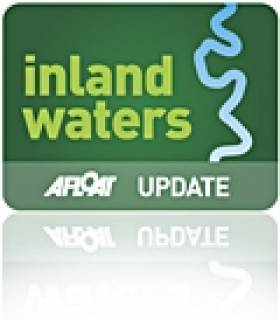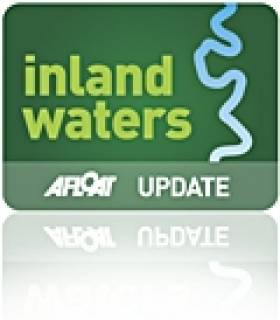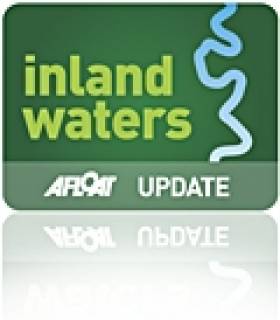Displaying items by tag: Waterways Ireland
Waterways Ireland Launches Latest 'Voyages & Visits' Guide
#InlandWaters - Waterways Ireland's latest tourism guide for Voyages and Visits was officially launched yesterday (Thursday 14 January) at Belfast's Holiday World Show.
The guide contains all the essential navigational and practical information required to help in planning a voyage or visit to the eight inland navigations on the island of Ireland under the remit of Waterways Ireland.
Voyages and Visits is free and available to order in print or download from the Waterways Ireland online shop HERE.
'What's On' Guide For Ireland's Waterways Calls For Entries
#InlandWaters - Waterways Ireland is producing a 'What's On' guide which features festivals and events occurring within an eight-mile corridor of the inland waterways under its remit.
Over 8,000 copies of the guide will be distributed free of charge to both local and national markets.
If you would like to be considered for inclusion in the 2016 edition, please complete the entry form (available HERE) and return it to:
Waterways Ireland,
Marketing & Communication,
2 Sligo Road,
Enniskillen,
Co Fermanagh BT74 7JY
Alternatively, you can fax to +44 (0)28 6634 6257 or email to [email protected].
Entries must be received no later than next Friday 22 January.
Warning When Accessing Flooded Areas In Boats & Flotation Devices
Waterways Ireland continues to advise caution while extensive flooding continues across all navigations. Advice has also been issued by ESB networks in relation to available clearance under overhead or sunken electricity cables.
ESB Networks is warning members of the public and emergency services to be vigilant when moving around flooded areas in boats and other flotation vehicles.
The electricity network is designed to have ample clearance for access and egress during normal conditions. However, when areas are flooded, this clearance level may be affected.
The electricity network is live and should not be approached. Electricity wires are dangerous even at close proximity and where clearance is compromised, you should not pass under them.
If you see any sagging electricity wires or wires submerged in water, please do not steer your boat over these. Do not use oars or anything else to lift or move electricity wires. Please report any poor clearance issues immediately to ESB Network at 1850 372 999.
ESB Networks is currently assessing the electricity network in flooded areas to assess damage and identify safety issues.
Waterways Ireland Sponsorship Programme Opens For 2016 Applications
#InlandWaters - Waterways Ireland's 2016 Sponsorship Programme is now open for anyone intending to run recreational waterway and waterside events in the coming new year.
Taking place annually for the past 10 years, the Waterways Ireland Sponsorship Programme has supported angling, canoeing, rowing, sailing and power sports competitions, learning experiences, community, historical and educational events for people with and without disabilities.
Sharon Lavin, head of marketing and communications with Waterways Ireland, said: "The Waterways Ireland Sponsorship Programme supported over 100 events in 2015 including angling, triathlons and many local community events along Ireland's inland waterways.
"Tourism and participation in recreation has a social and economic impact in waterfront communities and we want to see those communities continue to grow".
For an application pack, visit the Waterways Ireland website HERE, email Waterways Ireland at [email protected] or call +353 (0)71 96 50787. Terms and conditions apply.
The closing date the receipt of completed applications is Wednesday 16 December 2015 at 3pm.
Winners Announced In Waterways Ireland Heritage Plan Art & Photographic Competition
#InlandWaters - Paul Moore from Tullamore took home the Over 18s award in the Waterways Ireland Heritage Plan Art and Photographic Competition for his breathtaking picture of Bolands Lock house on the Grand Canal taken on a frosty winter morning.
Moore's photo was chosen earlier this month after reviewing a very strong group of entries, from which Under 18 award winner Christoph Wagner from Cologne was also selected for his picture of Clonmacnoise from the River Shannon.
Both winners received an iPad Air tablet. To view their winning photos, visit the Facebook gallery HERE.
Waterways Ireland Appoints New Senior Staff
#InlandWaters - Waterways Ireland has made two new appointments to its senior staff.
John Boyle has been appointed as director of business development. Formerly with the NI Fire Service, Boyle is from Derrylin, Co Fermanagh and will be based at Waterways Ireland HQ in Enniskillen.
Boyle's new role, which he took up in mid September, encompasses strategy, property and communications.
Elsewhere, Sharon Lavin has been appointed head of marketing and communications with Waterways Ireland and will be based in Carrick-on-Shannon, Co Leitrim.
From Roscommon, Lavin previously worked in a senior communications role with AIB Merchant Services.
Waterways Draft Heritage Plan Open For Public Consultation
#InlandWaters - Waterways Ireland has completed the development of its Draft Heritage Plan 2016-2020 for Ireland's inland waterways and has opened it up for public consultation until 6 November 2015.
Developed in consultation with a wide range of stakeholders, the plan encompasses the cultural, built and natural heritage of the inland waterway corridors and aims to "identify, conserve and promote the sustainable use of the unique waterways heritage for the enjoyment of this and future generations."
It is focused on connecting people, communities and the wider population with their local waterway and fostering a sense of place
Heritage plan working groups gave generously of their time to develop this strategy, and it is hoped to deliver the plan in partnership with them.
Waterways Ireland says implementation of the plan will require involvement from across all sectors: Government, NGOs, businesses and local communities.
"Only through this co-ordinated approach can the waterways remain strong, vibrant places to live, each with its own local distinctiveness, offering a space for the public to stand and appreciate 'living heritage' in all its forms," said the body for Ireland's waterways.
To participate in the public consultation, first download the draft plan HERE.
Submissions are invited in writing either by post (to Draft Heritage Plan Consultation, Waterways Ireland Western Regional Office, Dock Road, Drewsborough, Scarriff, Co Clare V94 H7N1) or by email to [email protected] by 6 November 2015 and should include the name and address of the person/organisation represented.
Additionally, a series of public information sessions – as previously reported on Afloat.ie – will be held throughout this month and into October, and feedback given at these will be included with the formal submissions.
Waterways Ireland says all written submissions and comments received during the above time period will be considered and the draft plan will be amended accordingly.
Senior Appointment on Shannon Navigation
Éanna Rowe has recently been appointed Regional Manager for the West with Waterways Ireland, to lead a multi disciplinary team in the management, maintenance and development of the Shannon Navigation. Reporting to the Chief Executive and a member of the Senior Management Team, Éanna is also a Director of Leave no Trace Ireland, member of the National Trails Advisory Committee and Chair of the Lakelands initiative.
Previously Head of Marketing and Communications with Waterways Ireland, Éanna was responsible for the formulation, development and implementation of the various strategies, policies and programmes from a Marketing, Research, Communications, Product Development and Visitor Services perspective. Éanna previously worked in a number of roles and grades within the Department of Arts, Heritage and the Gaeltacht.
A graduate of the Institute of Public Administration and of Athlone Institute of Technology Éanna holds a Degree in Public Management and a first class honours MBA.
#InlandWaters - Waterways Ireland is seeking contributions from the public on what they think best fulfils the theme 'Waterways Heritage'.
Participants of all ages are invited to enter the Heritage Art/Photographic Competition to be in with a chance to win an iPad Air.
Heritage of the inland waterways can include monuments, archaeological objects, heritage objects, architectural heritage, flora, fauna, wildlife habitats, landscapes and geology.
Entries should be of the waterways under the jurisdiction of Waterways Ireland, which include the Shannon Navigation, Erne System and Shannon-Erne Waterway; the Lower Bann Navigation; the Barrow Navigation; the Royal and Grand Canals; and the Ulster Canal (Upper Lough Erne to Clones).
The judges will select an entry (photograph, painting, sculpture, etc) which best captures the heritage of the inland waterways.
Entries will be divided into two categories: 18 years and over and under 18s. A prize of an iPad Air tablet will be awarded to the winner of each category.
Take the summer to prepare your entry and submit before the closing date for the competition, 30 September 2015. Terms and Conditions apply and details are included in the entry form HERE.
For further information and competition rules contact Sabine Browne of Waterways Ireland at 061 922 141 or [email protected]
#workspace – As Afloat.ie reported last week, "DoSpace.ie" Ireland's newest and most unique CoWorking space launched today in Grand Canal Dock, part of Dublin's Silicon Docks area on Ireland's Inland Waterways.
Occupying an 800 square foot, state of the art barge, DoSpace provides CoWorkers with short or long term desk space in Dublin 2.
It was founded by Graham Barker following his own fruitless search for reasonably priced and fun Silicon Docks office space. Graham, with support from Waterways Ireland, sourced and refitted The Grey Owl, one of Ireland's premier barges. The result, according to Barker, is both an affordable solution and a quirky work environment.
Speaking about the project, Graham said, "This is the kind of place that people want to work in – it's centrally located, next to the Dart, a Dublin Bikes stand across the road, beside all the big tech companies, and we are on the water! Everyone I've met has been very supportive – from Waterways Ireland to the CoWorking space community. I think most people can see the benefit that we bring to the area, and the sheer value that we offer to startups".
Commenting on the new start-up, Dawn Livingstone - Waterways Ireland Chief Executive said "We are really happy to have been able to work with DoSpace to bring this CoWorking business to the Grand Canal Dock. The Dock offers unique opportunities for business with the focus of technology businesses here in the area. There is an excellent range of startup and high growth businesses ready to take advantage of DoSpace CoWorking"
Grand Canal Dock is referred to as Silicon Docks because of the large concentration of technology companies and is seen by many as a symbol of Ireland's economic recovery. Tech giants like Facebook and Google, together with a myriad of smaller technology companies, have their European headquarters located here alongside incubation centres, such as Trinity's Technology and Enterprise campus.
One early adopter of DoSpace is Security First, a London based start-up creating tech to help human rights defenders work safely. Co-founder, Holly Kilroy, said "I've been blown away by the location and how useful the DoSpace community has been to us already. Having such a well connected CoWorking space in Dublin has saved us time and money and made it easier to move the company home."
DoSpace Dublin will be managed by David Bragason, DoSpace's Dublin's Community Manager. Tours of the DoSpace barge can be booked via their website at http://www.dospace.ie or by contacting David at 01 539 7935. Membership plans start from €50 a month. DoSpace is giving 10% of their desk space free of charge to nonprofit technology based startups.
































































